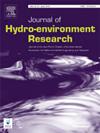基于一维数值模拟的窄带水库泥沙绕行隧道运行效率评价与优化
IF 2.3
3区 环境科学与生态学
Q2 ENGINEERING, CIVIL
引用次数: 0
摘要
泥沙绕道隧道(sbt)是一种旨在缓解水库沉积的水工结构,主要用于瑞士、日本和台湾。SBT效率取决于多种因素,包括来水产沙量、SBT入口位置、水库水位以及与洪水事件相关的SBT运行时间。为了评估旁路效率和优化SBT操作,开发了一种将沉积物旁路过程整合到一维数值模型中的方法,以模拟不同水力条件下的沉积动力学。瑞士Solis油藏的SBT监测为本研究提供了良好的基础。利用实测资料对模型进行了标定和验证,研究了某5年洪涝事件下SBT不运行、SBT运行时水库水位的影响和SBT运行的最佳持续时间。模拟结果表明,与不使用SBT相比,SBT操作可以有效地减少89%的沉降量。这相当于防止9%的活动存储卷损失。然而,SBT效率对储层运行非常敏感。当水库水位低于发电的最低运行水位时,效率达到最高,同时也向下游河段释放了较高的沉积物浓度。此外,更长的SBT运行时间增加了旁路效率,并将主动存储容量的损失降至最低,但同时也减少了水力发电量。因此,建议对不同情况下的净效益进行比较,以得出类似情况下的最佳SBT运行模式。总体而言,应用的方法可作为评价和优化SBTs沉积物管理效率的有用基础,从而有助于改善水库的可持续运行。本文章由计算机程序翻译,如有差异,请以英文原文为准。
Bypassing efficiency evaluation and optimization of sediment bypass tunnel operation in a narrow reservoir using 1D numerical modelling
Sediment Bypass Tunnels (SBTs) are hydraulic structures designed to mitigate reservoir sedimentation, mainly used in Switzerland, Japan, and Taiwan. The SBT efficiency depends on multiple factors including the incoming sediment yield, SBT inlet location, reservoir water level, and the timing of SBT operation relative to a flood event. To evaluate bypassing efficiency and optimize SBT operation, a methodology is developed to integrate sediment bypassing processes in a 1D numerical model for simulating the sedimentation dynamics under varying hydraulic conditions. The well-monitored case of the Solis reservoir in Switzerland with SBT operation serves as a good basis for this study. After calibrating and validating the model with the field data, three different categories of SBT operation scenarios are studied for a 5-year flood event: i) no SBT operation, ii) the effect of reservoir water level during SBT operation, and iii) the optimum duration of SBT operation. The simulations reveal that SBT operation is highly effective in reducing the amount of sedimentation by 89% compared to no SBT operation. This equals to the prevention of a 9% loss in active storage volume. However, the SBT efficiency is highly sensitive to reservoir operation. A maximum efficiency is achieved at a lower reservoir water level below the minimum operating level for energy generation, while it also releases higher sediment concentrations to the downstream reach. Furthermore, a longer duration of SBT operation increases the bypassing efficiency and minimizes the loss of active storage volume but goes along with a reduction in hydropower generation. Thus, a comparison of net benefits for different scenarios is suggested to derive an optimal SBT operation mode for similar situations. Overall, the applied methodology serves as a useful basis for evaluating and optimising the sediment management efficiency of SBTs and can thus contribute to improving the sustainable operation of reservoirs.
求助全文
通过发布文献求助,成功后即可免费获取论文全文。
去求助
来源期刊

Journal of Hydro-environment Research
ENGINEERING, CIVIL-ENVIRONMENTAL SCIENCES
CiteScore
5.80
自引率
0.00%
发文量
34
审稿时长
98 days
期刊介绍:
The journal aims to provide an international platform for the dissemination of research and engineering applications related to water and hydraulic problems in the Asia-Pacific region. The journal provides a wide distribution at affordable subscription rate, as well as a rapid reviewing and publication time. The journal particularly encourages papers from young researchers.
Papers that require extensive language editing, qualify for editorial assistance with American Journal Experts, a Language Editing Company that Elsevier recommends. Authors submitting to this journal are entitled to a 10% discount.
 求助内容:
求助内容: 应助结果提醒方式:
应助结果提醒方式:


